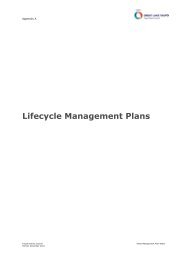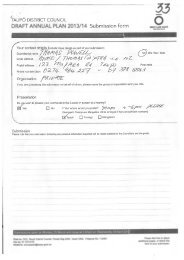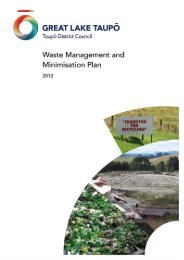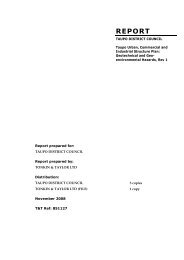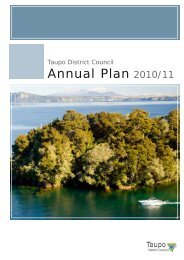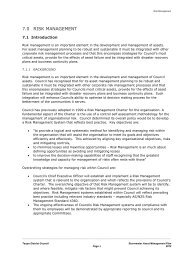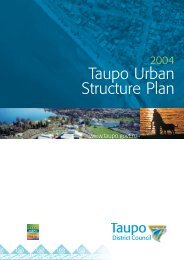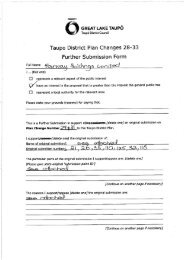Draft Annual Plan 2013/14 (10Mb PDF) - Taupo District Council
Draft Annual Plan 2013/14 (10Mb PDF) - Taupo District Council
Draft Annual Plan 2013/14 (10Mb PDF) - Taupo District Council
Create successful ePaper yourself
Turn your PDF publications into a flip-book with our unique Google optimized e-Paper software.
finances<br />
recognised as income over the<br />
periods necessary to match them<br />
with the related costs which they<br />
are intended to compensate, on<br />
a systematic basis. Government<br />
grants for assets are recognised<br />
as revenue when control over the<br />
asset is obtained.<br />
New Zealand Transport Agency<br />
roading subsidies are recognised<br />
as revenue upon entitlement,<br />
which is when conditions<br />
pertaining to eligible expenditure<br />
have been fulfilled.<br />
Other grants and bequests, and<br />
assets vested in the <strong>Council</strong><br />
– with or without conditions<br />
– are recognised as revenue<br />
when control over the assets is<br />
obtained. Grants and bequests<br />
are recognised at their fair value<br />
where there is a reasonable<br />
assurance that the grant or<br />
bequest will be received and<br />
that <strong>Council</strong> as the recipient<br />
will comply with all attached<br />
conditions<br />
Revenue from the sale of goods<br />
is recognised when the significant<br />
risks and rewards of ownership<br />
have been transferred to the<br />
buyer.<br />
Revenue from any services<br />
rendered (except as described<br />
above) is recognised in<br />
proportion to the stage of<br />
completion of the transaction<br />
at the balance date. The stage<br />
of completion is assessed by<br />
reference to surveys of work<br />
performed.<br />
Rental income from investment<br />
property is recognised on a<br />
straight-line basis over the term<br />
of the lease. Lease incentives<br />
granted are recognised as an<br />
integral part of the total rental<br />
income.<br />
Development contributions<br />
and financial contributions are<br />
recognised as revenue when<br />
<strong>Council</strong> invoices the customer.<br />
Dividend income shall<br />
be recognised when the<br />
shareholder’s right to receive<br />
payment is established.<br />
Interest income is recognised<br />
as it accrues, using the effective<br />
interest method.<br />
Where a physical asset is<br />
acquired for nil or nominal<br />
consideration, the fair value of the<br />
asset received is recognised as<br />
revenue. Assets vested in Taupō<br />
<strong>District</strong> <strong>Council</strong> are recognised<br />
as revenue when control over the<br />
asset is obtained.<br />
General rates are not allocated<br />
to significant activities and<br />
are included as general rate<br />
revenue in the Statement of<br />
Comprehensive Income.<br />
No revenue is recognised if there<br />
are significant uncertainties<br />
regarding recovery of the<br />
consideration due, associated<br />
costs or the possible return of<br />
goods.<br />
3.5 Expenses<br />
Leases<br />
Leases in which substantially<br />
all of the risks and rewards of<br />
ownership transfer to the lessee<br />
are classified as finance leases.<br />
At inception, finance leases<br />
are recognised as assets and<br />
liabilities on the Statement of<br />
Financial Position at the lower<br />
of the fair value of the leased<br />
property and the present value<br />
of the minimum lease payments.<br />
Any additional direct costs of<br />
the lessee are added to the<br />
amount recognised as an asset.<br />
Subsequently, assets leased<br />
under a finance lease are<br />
depreciated as if the assets are<br />
owned.<br />
Operating lease payments<br />
Payments made under operating<br />
leases are recognised in the<br />
Statement of Comprehensive<br />
Income on a straight-line basis<br />
over the term of the lease.<br />
Lease incentives received are<br />
recognised in the Statement of<br />
Comprehensive Income as an<br />
integral part of the total lease<br />
expense.<br />
Finance lease payments<br />
Minimum lease payments are<br />
apportioned between the finance<br />
charge and the reduction of the<br />
outstanding liability. The finance<br />
charge is allocated to each period<br />
during the lease term, so as<br />
to produce a constant periodic<br />
rate of interest on the remaining<br />
balance of the liability.<br />
Financing costs<br />
Net financing costs comprise<br />
interest payable on borrowings<br />
calculated using the effective<br />
interest rate method, foreign<br />
exchange losses, and losses<br />
on hedging instruments that are<br />
recognised in the Statement of<br />
Comprehensive Income. The<br />
interest expense component<br />
of finance lease payments is<br />
recognised in the Statement of<br />
Comprehensive Income using the<br />
effective interest rate method.<br />
3.6 Equity<br />
Equity is the community’s interest<br />
in the <strong>Council</strong> as measured by<br />
the value of total assets less<br />
total liabilities. Public Equity is<br />
disaggregated and classified<br />
into a number of reserves to<br />
enable clearer identification of the<br />
specified uses <strong>Council</strong> makes of<br />
its accumulated surpluses. The<br />
public equity of <strong>Council</strong> is made<br />
up of the following components:<br />
• Accumulated funds<br />
• <strong>Council</strong> created reserves<br />
• Restricted reserves<br />
• Revaluation reserves<br />
3.7 Reserves<br />
Reserves are a component of<br />
Public Equity and represent<br />
a particular use to which<br />
parts of equity have been<br />
assigned. Reserves may be<br />
legally restricted or created by<br />
the <strong>Council</strong>. <strong>Council</strong> Created<br />
Reserves are reserves<br />
established by <strong>Council</strong> decision.<br />
The <strong>Council</strong> may alter them<br />
without reference to any third<br />
party or the Courts. Transfers<br />
to and from these reserves are<br />
at the discretion of the <strong>Council</strong>.<br />
Restricted Reserves are those<br />
reserves subject to specific<br />
conditions accepted as binding<br />
by the <strong>Council</strong>, and which <strong>Council</strong><br />
may not revise without reference<br />
to a third party. Transfers from<br />
these reserves may be made only<br />
for certain specified purposes or<br />
when certain specified conditions<br />
are met.<br />
Asset Revaluation Reserves<br />
arise from certain asset classes<br />
being revalued, with these<br />
classes including land, buildings,<br />
infrastructural assets, restricted<br />
assets and investments.<br />
The treatment of revaluation<br />
movements is detailed in item<br />
3.13.1 of the policies.<br />
3.8 Cash and cash<br />
equivalents<br />
Cash and cash equivalents<br />
comprise cash balances and<br />
our neighbourhood, our future 73



